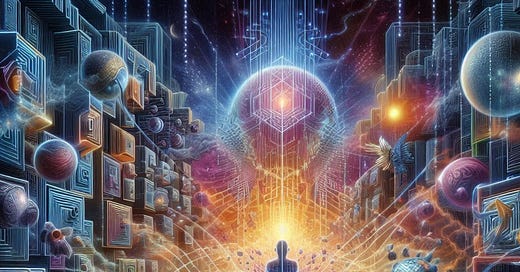The reality we now experience in 2025 is already multi-dimensional, whether we recognize it or not. When you feel a pang of emotion from a stranger's social media post, compare your life to a fictional character's, or assign deep meaning to a brand logo, you're participating in meta-reality – a space where symbols, meanings, and physical existence interweave in increasingly complex ways.
Ancient mystical traditions have long viewed human experience as a compressed version of higher-dimensional reality, our consciousness acting as a filter that collapses infinite possibility into comprehensible form. The Kabbalistic Tree of Life maps how divine energy filters down through multiple dimensions into physical reality. Today, we're creating our own mystical frameworks, often unknowingly, as we navigate between physical and digital spaces, between direct experience and symbolic meaning.
This navigation of meta-reality mirrors what philosopher Jean Baudrillard termed hyperreality – where the distinction between reality and simulation collapses. When a teenager responds emotionally to a TikTok trend, they're experiencing a real physiological response triggered by a complex web of social signals, digital artifacts, and collective meaning-making. The symbols have become, as Baudrillard predicted, more "real" than what they represent.
Which brings us to art, and specifically, how traditional forms like jazz, classical, and folk music might evolve to bridge these dimensional spaces intentionally and meaningfully. Imagine a jazz performance where audiences don't just listen – they feel, see, and shape the music in real-time through haptic feedback and interactive visualizations. The boundary between performer and audience blurs as emotional responses manifest as flowing colors and forms, creating a shared dimensional space of creative expression.
Gilles Deleuze's concept of rhizomes offers a framework for understanding these interconnected experiences. Like a rhizome, meaning in meta-reality flows non-hierarchically, connecting any point to any other point. A single musical performance might simultaneously exist as sound waves, digital data, emotional responses, social media posts, and collective memory, with each dimension influencing and being influenced by the others.
This isn't just about adding technology to old art forms. It's about making visible the invisible dimensions we already inhabit. When a folk song makes you feel connected to centuries of human experience, you're already engaging with multiple dimensions of meaning. Technology can help us consciously explore and expand these connections, creating new interfaces for experiencing the depth that has always existed in these art forms.
As short-form content and algorithmic pop music dominate our cultural landscape, these multi-modal approaches to performance might help us maintain depth and complexity in our artistic experiences. They mirror how mystical traditions use physical objects and rituals as interfaces to access higher planes of reality. Just as a tantric practitioner uses a mandala as a map of consciousness, these technologically-enhanced performances could serve as gateways to deeper states of collective experience.
As meta-reality becomes our default state of existence, these artistic experiments might help us maintain awareness of our dimensional compression and expansion. Even those who've never heard terms like meta-reality or dimensional compression intuitively understand that a loved one's social media post carries weight beyond its pixels, or that a powerful piece of music creates space beyond its sound waves.
The tools for this exploration are emerging: haptic feedback that lets you feel a bass line on your smartphone, real-time visualizations that transform collective emotional responses into living art, interactive spaces that respond to and shape the performance. But more importantly, we're developing new literacy for understanding how meaning moves between dimensions – physical, digital, emotional, social, spiritual.
As algorithmic content and short-form media dominate our cultural landscape, these multi-modal approaches to performance might help us maintain depth and complexity in our artistic experiences. They mirror how mystical traditions use physical objects and rituals as interfaces to access higher planes of reality. Just as a tantric practitioner uses a mandala as a map of consciousness, these technologically-enhanced performances could serve as gateways to deeper states of collective experience.
What if the future of art isn't about choosing between tradition and technology, but about making visible the multiple dimensions we already inhabit? How might conscious exploration of these spaces through music and art help us maintain depth and meaning in an increasingly meta-real world? Perhaps most importantly, how can these experiences help us all – from digital natives to technological skeptics – better understand and navigate the complex reality we're already creating together?
These aren't just theoretical questions. As we develop new ways of experiencing and creating art, we're also developing new ways of understanding reality itself. In the space between ancient wisdom and emerging technology, between physical sensation and digital abstraction, we might find new maps for navigating our evolving consciousness.




